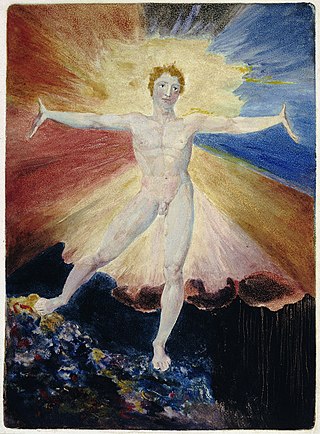
Boudica or Boudicca was a queen of the ancient British Iceni tribe, who led a failed uprising against the conquering forces of the Roman Empire in AD 60 or 61. She is considered a British national heroine and a symbol of the struggle for justice and independence.

The Mauritius Command is the fourth naval historical novel in the Aubrey-Maturin series by Patrick O'Brian, first published in 1977.

In the mythology of William Blake, Albion is the primeval man whose fall and division results in the Four Zoas: Urizen, Tharmas, Luvah/Orc and Urthona/Los. The name derives from the ancient and mythological name of Britain, Albion.

Enya is the debut studio album by Irish singer, songwriter, and musician Enya, released in March 1987 by BBC Records in the UK and by Atlantic Records in the US. It was renamed as The Celts for the 1992 international re-release of the album by WEA Records in Europe and by Reprise Records in the US. The album features a selection of music that she recorded for the soundtrack to The Celts, a BBC documentary series about the origins, growth, and influence of Celtic culture.
Four ships and a shore establishment of the Royal Navy have borne the name HMS Boadicea after Boadicea, queen of the Iceni in Roman Britain, whilst another ship was planned but never completed:

The Boadicea-class cruiser was a pair of scout cruisers built for the Royal Navy in the first decade of the 20th century. They were the first class of this type to be fitted with steam turbine machinery. Upon completion in 1909–10, the sister ships served as flotilla leaders for destroyer flotillas of the First Fleet until 1913 when they were assigned to battleship squadrons. When the First World War began in August 1914, they remained with their squadrons as the First Fleet was incorporated into the Grand Fleet, although they changed squadrons over the course of the war. Both ships were present during the Battle of Jutland in mid-1916, but neither fired a shot. They were converted into minelayers the following year and both ships laid minefields in early 1918 in addition to other missions. The sisters were reduced to reserve in 1919 and sold for scrap in 1921 and 1926.

HMS Boadicea was a B-class destroyer built for the Royal Navy (RN) around 1930. Initially assigned to the Mediterranean Fleet, she was transferred to the Home Fleet in 1936. Before her departure, the ship evacuated civilians from Spain during the beginning of the Spanish Civil War of 1936–1939. Boadicea later spent considerable time in Spanish waters, enforcing the arms blockade imposed by Britain and France on both sides of the conflict. During World War II, the ship spent the bulk of the war on convoy escort duty in British waters and participated in the Battle of the Atlantic, Operation Torch, the Russian Convoys, and in the Normandy landings. Badly damaged by German dive bombers in 1940, she was sunk almost exactly four years later by German aircraft.

HMS Boadicea was a frigate of the Royal Navy. She served in the Channel and in the East Indies during which service she captured many prizes. She participated in one action for which the Admiralty awarded the Naval General Service Medal. She was broken up in 1858.

Written by Baroness Orczy, the author of The Scarlet Pimpernel, Meadowsweet was first published in 1912.

HMS Boadicea was the lead ship of her class of scout cruisers built for the Royal Navy in the first decade of the 20th century. She led the 1st Destroyer Flotilla from completion until the ship was transferred to the 3rd Destroyer Flotilla in mid-1912. A year later Boadicea was reassigned to the 2nd Battle Squadron and she spent the bulk of World War I with that squadron. The ship was present at, but did not fight in, the Battle of Jutland in mid-1916. Boadicea was converted into a minelayer at the end of 1917 and made three sorties to lay her mines before the end of the war. She was placed in reserve after the war and taken out of service in 1920. The ship was used for harbour service at Dartmouth until she was sold for scrap in 1926.
The action of 13 September 1810 was an inconclusive frigate engagement during the Napoleonic Wars between British Royal Navy and French Navy frigates during which a British frigate was defeated by two French vessels near Isle de France, but British reinforcements were able to recapture the ship before the French could secure her. The British frigate was HMS Africaine, a new arrival to the Indian Ocean. She was under the command of Captain Robert Corbet, who had served there the previous year. Corbet was a notoriously unpopular officer and his death in the battle provoked a storm of controversy in Britain over claims that Corbet had either committed suicide at the shame of losing his ship, been murdered by his disaffected crew, or been abandoned by his men, who were said to have refused to load their guns while he remained in command. Whether any of these rumours were accurate has never been satisfactorily determined, but the issue has been discussed in several prominent naval histories and was the subject of at least one lawsuit.

The action of 18 September 1810 was a naval battle fought between British Royal Navy and French Navy frigates in the Indian Ocean during the Napoleonic Wars. The engagement was one of several between rival frigate squadrons contesting control of the French island base of Île de France, from which French frigates had raided British trade routes during the war. The action came in the immediate aftermath of the Battle of Grand Port, in which four British frigates had been lost, and just four days after a fifth British frigate had been captured and subsequently recaptured in the action of 13 September 1810. In consequence of the heavy losses the British force had suffered, reinforcements were hastily rushed to the area and became individual targets for the larger French squadron blockading the British base at Île Bourbon.

John Maitland was an officer of the Royal Navy, who saw service during the French Revolutionary and Napoleonic Wars, eventually rising to the rank of Rear-Admiral.
Boadicea is a 1927 British historical film directed by Sinclair Hill and starring Phyllis Neilson-Terry, Lillian Hall-Davis, and Clifford McLaglen. It depicts the life of the Celtic Queen Boudica (Boadicea) and her rebellion against the Roman Empire.
Boudica was a 1st-century queen of the British Iceni tribe.

Celaenorrhinus boadicea, commonly known as Boadicea's sprite, is a species of butterfly in the family Hesperiidae. It is found in Nigeria, Cameroon, Gabon, the Republic of the Congo, the Democratic Republic of the Congo, Uganda, Tanzania and Zambia. The habitat consists of forests, but it is also found in agricultural lands with a full canopy.

Boadicea and Her Daughters is a bronze sculptural group in London representing Boudica, queen of the Celtic Iceni tribe, who led an uprising in Roman Britain. It is located to the north side of the western end of Westminster Bridge, near Portcullis House and Westminster Pier, facing Big Ben and the Palace of Westminster across the road. It is considered the magnum opus of its sculptor, the English artist and engineer Thomas Thornycroft. Thornycroft worked on it from 1856 until shortly before his death in 1885, sometimes assisted by his son William Hamo Thornycroft, but it was not erected in its current position until 1902.

The Nudariina are a subtribe of lichen moths in the family Erebidae. The taxon was described by Carl Julius Bernhard Börner in 1920.
The wrecking of the Sea Horse, Boadicea and Lord Melville took place during a gale off the east coast of Ireland on 30 January 1816. These ships were initially travelling together carrying soldiers and their families to Cork at the end of the Napoleonic War, and were wrecked with heavy loss of life.
HMS Utile was the French 16-gun privateer brig-sloop Utile launched in 1799 that the Royal Navy captured in 1799 and took into service; she foundered in the Mediterranean in 1801.












